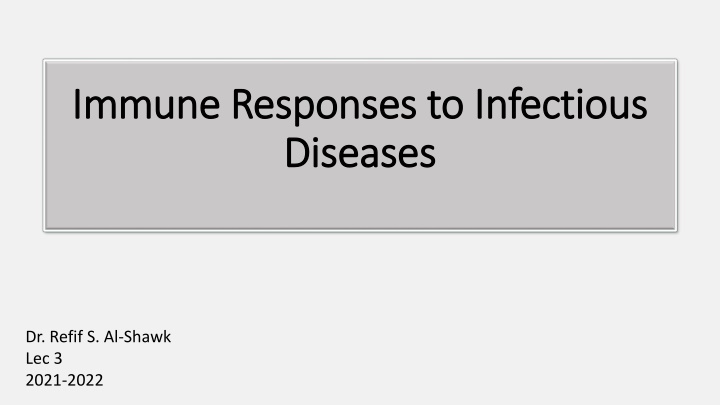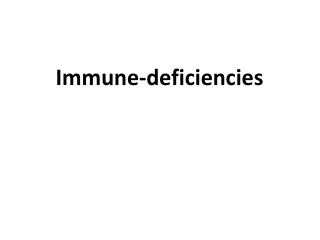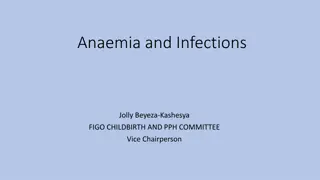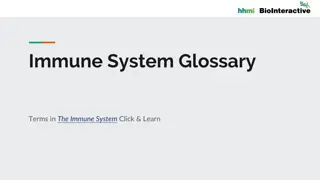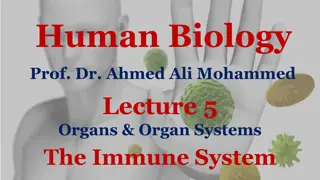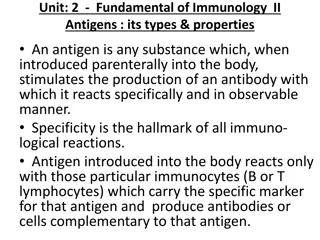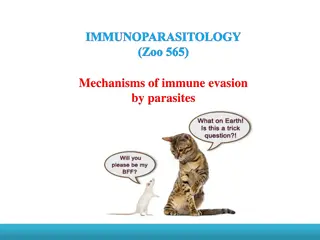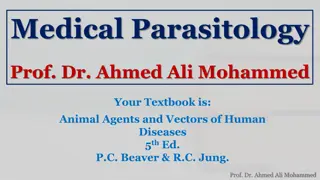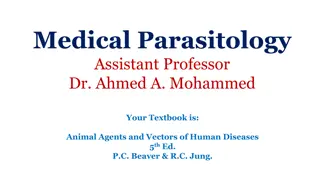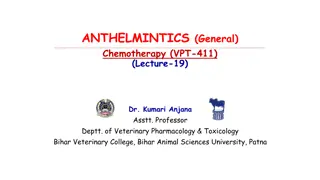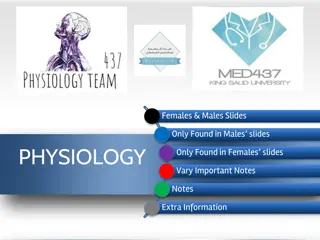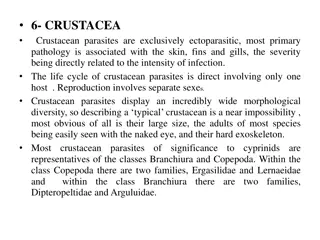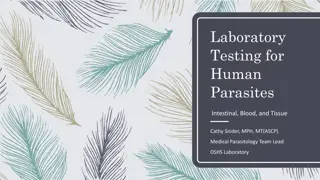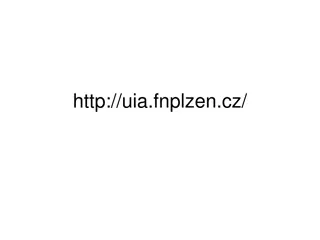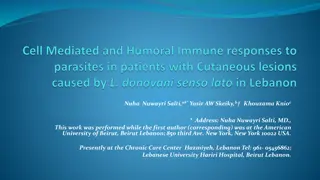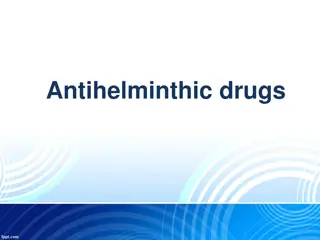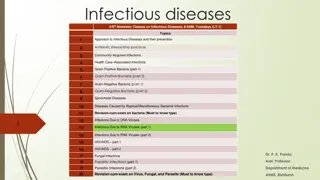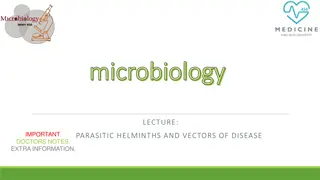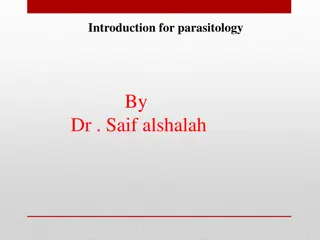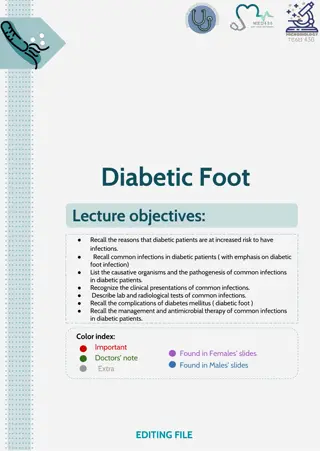Immune Responses to Parasitic Infections and Evasive Strategies by Protozoan and Helminth Parasites
Parasitic infections pose complex challenges to the immune system due to the diverse nature of parasites, including protozoans and helminths. Protozoan parasites move between arthropod vectors and mammalian hosts, requiring both humoral and cell-mediated immune responses. Meanwhile, helminths, as multicellular organisms, can evade immune detection, leading to chronic infections. Certain parasites, like trypanosomes causing African sleeping sickness, use evasive strategies with variant protein coats. Understanding these immune interactions is crucial for managing parasitic diseases effectively.
Download Presentation

Please find below an Image/Link to download the presentation.
The content on the website is provided AS IS for your information and personal use only. It may not be sold, licensed, or shared on other websites without obtaining consent from the author.If you encounter any issues during the download, it is possible that the publisher has removed the file from their server.
You are allowed to download the files provided on this website for personal or commercial use, subject to the condition that they are used lawfully. All files are the property of their respective owners.
The content on the website is provided AS IS for your information and personal use only. It may not be sold, licensed, or shared on other websites without obtaining consent from the author.
E N D
Presentation Transcript
Immune Responses to Infectious Immune Responses to Infectious Diseases Diseases Dr. Refif S. Al-Shawk Lec 3 2021-2022
Parasitic Infections Parasitic Infections The term parasite encompasses a vast array of infectious protozoans (unicellular) and metazoans (helminths or worms). Protozoan parasites, although eukaryotic, inhabit intracellular spaces in their human host for at least one of their life cycle stages. Helminths are multicellular eukaryotes that can be quite large in their adult stages. These organisms typically live and reproduce exclusively outside host cells, sometimes occupying host body cavities, like the gut. One of the biggest challenges posed to the immune response by most parasites is their complicated life cycle, leading to changes in antigenic structure and location over time. Effective immune response will depend on the type of organism, the location of the infection, and the life cycle stage of the parasite.
Protozoan Protozoan Parasites are a Diverse Set of Parasites are a Diverse Set of Unicellular Eukaryotes Unicellular Eukaryotes protozoan parasites move from their arthropod vector hosts, such as mosquitoes and flies (e.g., the parasites that cause malaria and African sleeping sickness, respectively), to their mammalian hosts when the infected insects draw blood during feeding. When parasites are in the bloodstream, gut, or interstitial fluid of their human host, humoral immunity is the most effective response. However, these stages can be very transient or include evasion strategies, presenting little opportunity for clonal selection of lymphocytes or antibody attachment. Those parasites that undergo intracellular life cycle stages require cell- mediated immune reactions as a defense.
Evasive strategy of parasitic infection Evasive strategy of parasitic infection The trypanosomes that cause African sleeping sickness use a novel evasive strategy that employs up to 1000 possible variants of protein coat to outrun the immune response. The individual immune response to another trypanosome, leishmania, can head in one of two polarized directions, depending on host and pathogen characteristics; TH1-driven response that effectively limits pathology or a TH2-mediated pathway leading to rampant dissemination and progressive disease. Our struggle against malaria, the protozoan, with a complicated life cycle involving multiple extracellular and intracellular stages of infection, like a red blood cell stage that is particularly refractory to immune detection.
Parasitic Worms ( Parasitic Worms (Helminths Weak Immune Responses Weak Immune Responses Helminths) Typically Generate ) Typically Generate Metazoan parasites, or helminths (worms), are responsible for a range of diseases in humans and animals. Adult forms of helminths are large, multicellular organisms that can often be seen with the naked eye.
Helminths do not multiply within their human hosts results in fewer foreign epitopes that can be recognized by the immune system weak engagement to each generating relatively poor immune reactivity. Adult helminths are also too big for phagocytic cells to engulf. The best approach may be expulsion rather than the typical humoral opsonization and digestion response. HOW? IgE-mediated responses that result in mast cell degranulation can help, ejecting the worm from the body via the release of histamines and leukotrienes that induce muscle contractions and mucus production (e.g., coughing, vomiting, or explosive diarrhea). The effective immune responses against metazoan parasites is TH2-type responses, including ILC2s(type 2 innate lymphoid cells), IL-4 production, TH2- cell activation, and the production of IgE over IgG. {Interestingly, a paucity or lack of early life exposures to helminthic parasites, as occurs in highly developed and urban settings, is credited with a lower threshold for TH2-type response induction, resulting in overproduction of IgE: heightened type I, IgE-mediated, allergic responses to random, benign environmental antigens}
Schistosomiasis: Low Antigenicity and Large Size Pose Unique Schistosomiasis: Low Antigenicity and Large Size Pose Unique Challenges to Immune Detection and Elimination of Helminths Challenges to Immune Detection and Elimination of Helminths Most symptoms of schistosomiasis are initiated by the eggs, which invade tissues and cause hemorrhage. A chronic state can develop in which the unexcreted eggs induce cell-mediated DTH reactions, resulting in large granulomas that can obstruct the venous blood flow to the liver or bladder. An immune response does develop to the schistosomes, but it is usually not sufficient to eliminate the adult worms. Adult schistosome worms have several unique mechanisms that protect them from immune defenses. These include decreasing the expression of antigens on their outer membrane Enclosing themselves in a glycolipid-and-glycoprotein coat derived from the host, masking the presence of their own antigens. Among the antigens observed on the adult worm are the host s own ABO blood-group and histocompatibility antigens. The immune response is, of course, diminished by this covering made of the host s self antigens, which contributes to the lifelong persistence of these organisms.
Fungal Infections Fungal Infections Infections may result from introduction of exogenous organisms due to injury or inhalation, or during host disruptions that allow endogenous organisms such as the commensals to induce disease. Fungi are ubiquitous in our environment, widespread fungal infections are often a sign of reduced immune competence in the host. In these cases, fungal agents may penetrate mucosal barriers and gain access to extracellular spaces deeper in the body.
Fungal Infections Fungal Infections Virulence types can be divided into primary, indicating the rare agents with high pathogenicity, and opportunistic, denoting weakly virulent agents that primarily infect individuals with compromised immunity. Most fungal infections of healthy individuals are resolved rapidly, with few clinical signs. Diseases caused by these fungi are named for the agent; for example, Cryptococcus neoformans causes cryptococcosis and Blastomyces dermatitidis causes blastomycosis. In each case, infection with these environmental agents is aided by predisposing conditions that include AIDS, immunosuppressive drug treatment, and malnutrition.
Innate Immunity Controls Most Fungal Infections Innate Immunity Controls Most Fungal Infections Physical barriers and agents involved in innate immunity control infection by most fungi. The presence of commensal organisms also helps control the growth of potential pathogens. Long-term treatment with broad-spectrum antibiotics, which destroy normal mucosal bacterial flora and often lead to oral or vulvovaginal infection with Candida albicans, an opportunistic fungal agent. Phagocytosis by neutrophils is a strong defense against most fungi, and therefore people with neutropenia (low neutrophil count) are generally more susceptible to fungal disease.
Resolution of infection in normal, healthy individuals is often rapid and initiated by: Recognition of common fungal cell wall PAMPs by PRRs, especially those in the C- type lectin receptor (CLR) family. The three most immunologically relevant cell wall components include -glucans (polymers of glucose), mannans (long chains of mannose), and chitin (a polymer of N-acetylglucosamine). The importance of certain PRRs for resolving fungal infection has been demonstrated by the increased susceptibility to mycoses. For instance: certain molecular variants of dectin-1, a C-type lectin receptor, are associated with chronic mucocutaneous candidiasis. Toll like receptors 2, 4, and 9, as well as complement receptor 3 (CR3), are also involved in the innate response to fungi. Recognition of these fungal cell wall components leads to the activation of complement (via both alternative and lectin pathways) along with the induction of phagocytosis and destruction of fungal cells.
fungi have evolved mechanisms to fungi have evolved mechanisms to evade innate innate immune response immune response evade the the These include production of a capsule, as in the case of C. neoformans, which blocks PRR binding. Another evasion strategy employed by this organism involves fungi- induced expulsion from macrophages after phagocytosis. Because this does not kill host cells it avoids induction of inflammation and further activation of immunologic attention.
Immunity against Fungal Pathogens Can Be Immunity against Fungal Pathogens Can Be Acquired Acquired Strong TH1 responses and the production of IFN- , important for optimal macrophage activation, are most commonly associated with protection against fungi. Conversely, TH2-cell and Treg -cell responses, or their products, are associated with susceptibility to mycoses. This is apparent in patients displaying distinct T helper responses to coccidioidomycosis, where TH1 immune activity is associated with a mild, asymptomatic infection and TH2 responses result in a severe and often relapsing form of the disease. Regulatory role for TH17 cells in controlling adaptive immunity against fungi has been postulated, where these cells are hypothesized to help support TH1-cell and discourage TH2-cell activation.
Emerging and Re Emerging and Re- -emerging Infectious Diseases emerging Infectious Diseases At least yearly, it seems, an outbreak of a new or old infectious disease makes the news, accompanied by reports of severe illness and even death. Defines emerging infectious diseases as those that have arisen or increased in the human population in the past 2 decades. Examples include news-makers like SARS and Zika virus and recently COVID-19 The emergence of these infectious agents is linked to opportunistic situations: Expanding animal reservoirs and/or arthropod vector habitats (associated with climate change), Increased travel by human hosts Enhanced contact between wild animals that harbor these infections and humans, linked to factors such as population growth, encroachment (intrusion), and deforestation. The reasons why previously controlled infectious agents might re-emerge include increasing populations with immune compromise, the acquisition of antibiotic resistance by infectious agents, and a decrease in vaccination rates in some areas.
Referrences Referrences : : Kuby immunology 8th edition, 2019 Cellular and molecular immunology 9th edition , 2018 by Abul K. Abbas
